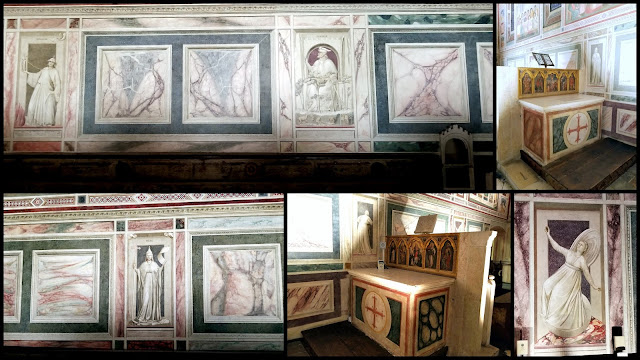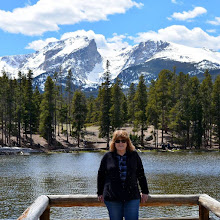After spending a day in Verona--click here and here to read those posts--my husband and I traveled by train to our next stop, Padua, Italy, the next day. Padua is only an hour away from Venice, and for many centuries it was a rich commune that challenged both Verona and Venice as the seat of power in the Veneto region of Northern Italy before Venice permanently occupied Padua in 1405. It became famous as containing Italy's second oldest university, founded in 1222, where Galileo Galilei was once a lecturer. I was nostalgic to return to Padua, as it was another of the cities I visited long ago as a high school student, although the only site we visited was the Basilica of Saint Anthony--more about that in my next post. This trip to Padua I was determined to visit the Scrovegni Chapel, which contains religious frescos painted by Giotto di Bondone in 1305, and are considered one of the most important masterpieces of Western Art!
The Scrovegni Chapel is located in Piazza Eremitani, a short walk from the train station. The chapel was originally attached to the Scrovegni family palace, built after 1300, following the outline of the remains of a Roman arena that was located there. Advance reservation to visit the chapel is mandatory and can be made on the Scrovegni Chapel website, 24 hours in advance. Visits are timed, and only 25 people at a time are admitted. It is required that you stand in an air-conditioned waiting room for 15 minutes so that the microclimate can be stabilized. Then the chapel inner doors are opened quickly to allow everyone inside and closed immediately. Inside you are allowed 15 minutes to view the frescos. This is all done to preserve the integrity of the frescos from damage. I was not sure I could bring my camera into the chapel, so I left it at our Bed and Breakfast rental. Happily, we were allowed to use our cell phones to take photos and videos as long as the flash was off.
Mindful of our time limit, I took the video above quickly when I entered--click here to watch it on my facebook page if you can't see it above. It took Giotto two years to paint the 38 fresco paintings within the chapel.
The beauty and colors of the fresco paintings on the chapel walls were exquisite!
Commissioned to the Tuscan artist by the affluent Paduan banker Enrico Scrovegni in the early 1300s, the frescoes depict the narrative lives of the Virgin Mary and of Jesus Christ. Enrico Scrovegni's tomb, seen above, is also located inside the chapel.
The ceiling of the chapel.
Close-ups of Mary and Jesus that are located on the ceiling.
The fresco paintings are considered so significant as the figures they depict are no longer elongated or stylized as in the Byzantine style, they wear clothes that hang naturally, and are three-dimensional in shape. They come alive and tell a story. Giotto also made use of perspective, which was not common at the time. They are considered the precursor to the Renaissance style of art.
Around one hundred years after Giotto di Bondone's death, artists of the emerging Renaissance began to seriously study and imitate his work at Scrovegni. Michelangelo, Leonardo da Vinci, Masaccio and Raphael all visited and studied the chapel at one time or another to learn the techniques of their predecessor.
Paintings of Jesus' life were on one side of the chapel.
Paintings of Mary's life were depicted on the opposite side.
The Last Judgement is depicted above the entrance portal and symbolic representations of virtues and vices adorn the side walls. On the triumphal arch over the altar, you can see God, who instructed the archangel Gabriel to announce the birth of Jesus.
Please click on to enlarge
Some close-ups of segments of the paintings
The bottom tiers of the longer walls of the chapel feature 14 allegories, in monochrome, symbolizing Vices on the north wall and Virtues on the south wall, along with faux marbling and small altars on either side.
The Scrovegni Chapel has remained a symbol of artistic genius and innovation throughout the centuries and I was thrilled to visit it. There is much more to see in Padua and in my next post I'll show you more sights from this historic and magnificent city.







































































